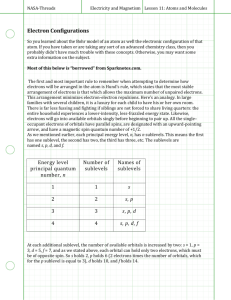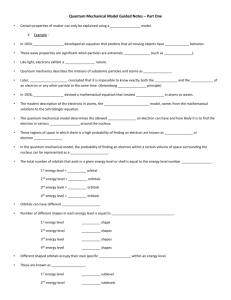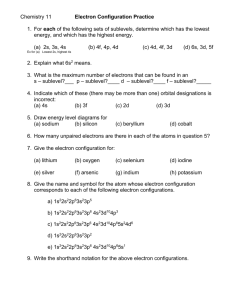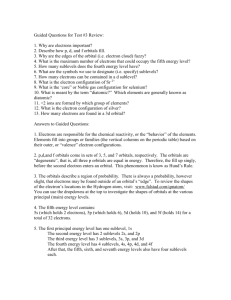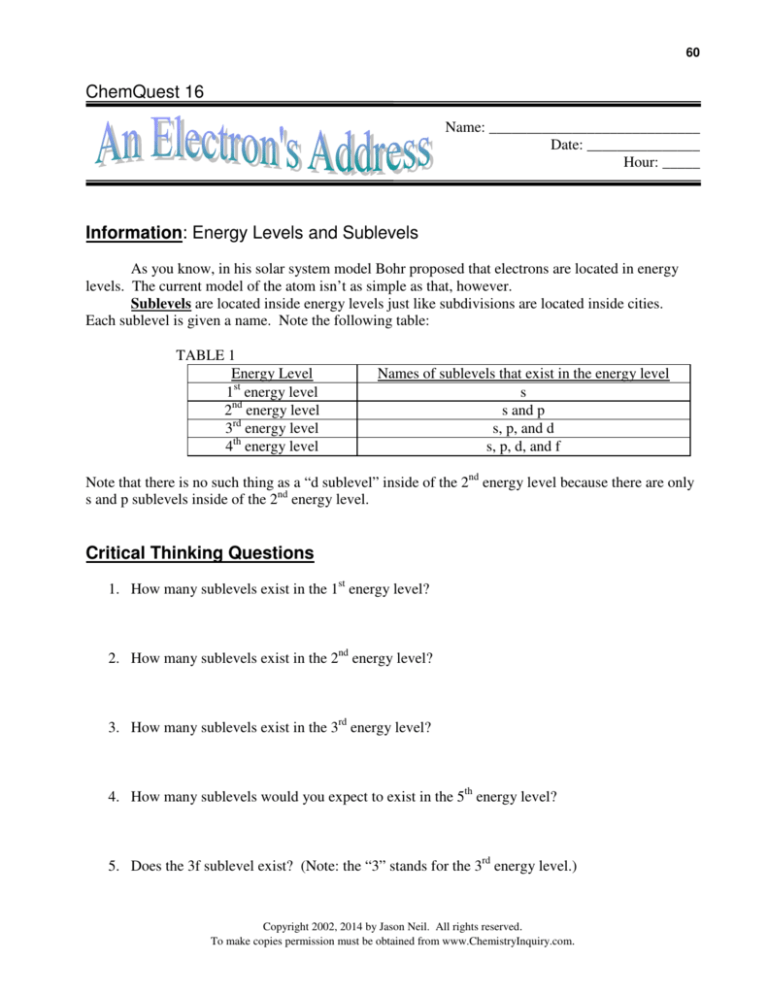
60
ChemQuest 16
Name: ____________________________
Date: _______________
Hour: _____
Information: Energy Levels and Sublevels
As you know, in his solar system model Bohr proposed that electrons are located in energy
levels. The current model of the atom isn’t as simple as that, however.
Sublevels are located inside energy levels just like subdivisions are located inside cities.
Each sublevel is given a name. Note the following table:
TABLE 1
Energy Level
1st energy level
2nd energy level
3rd energy level
4th energy level
Names of sublevels that exist in the energy level
s
s and p
s, p, and d
s, p, d, and f
Note that there is no such thing as a “d sublevel” inside of the 2nd energy level because there are only
s and p sublevels inside of the 2nd energy level.
Critical Thinking Questions
1. How many sublevels exist in the 1st energy level?
2. How many sublevels exist in the 2nd energy level?
3. How many sublevels exist in the 3rd energy level?
4. How many sublevels would you expect to exist in the 5th energy level?
5. Does the 3f sublevel exist? (Note: the “3” stands for the 3rd energy level.)
Copyright 2002, 2014 by Jason Neil. All rights reserved.
To make copies permission must be obtained from www.ChemistryInquiry.com.
61
Information: Orbitals
So far we have learned that inside energy levels there are different sublevels. Now we will look at
orbitals. Orbitals are located inside sublevels just like streets are located inside subdivisions.
Different sublevels have different numbers of orbitals.
TABLE 2
# of Orbitals
Sublevel
Possible
s
1
p
3
d
5
f
7
Here’s an important fact: only two electrons can fit in each orbital. So, in an s orbital you can have a
maximum of 2 electrons; in a d orbital you can have a maximum of 2 electrons; in any orbital there
can only be two electrons.
Since a d sublevel has 5 orbitals (and each orbital can contain up to two electrons) then a d sublevel
can contain 10 electrons (= 5 x 2). Pay attention to the difference between “sublevel” and “orbital”.
Critical Thinking Questions
6. How many orbitals are there in a p sublevel?
7. How many orbitals are there in a d sublevel?
8. a) How many total sublevels would be found in the entire 2nd energy level?
b) How many orbitals would be found in the entire 2nd energy level?
9. a) How many electrons can fit in an f sublevel?
b) How many electrons can fit in an f orbital?
10. How many electrons can fit in a d orbital? in a p orbital? in any kind of orbital?
11. In your own words, what is the difference between a sublevel and an orbital?
12. How many electrons can fit in each of the following energy levels:
1st energy level =
2nd energy level =
3rd energy level =
4th energy level =
Copyright 2002, 2014 by Jason Neil. All rights reserved.
To make copies permission must be obtained from www.ChemistryInquiry.com.
62
Information: Representing the Most Probable Location of an Electron
The following is an “address” for an electron—a sort of shorthand notation. The diagram below
represents an electron located in an orbital inside of the p sublevel in the 3rd energy level.
EXAMPLE #1:
Some important facts about the above diagram:
• The arrow represents an electron.
• The upward direction means that the electron is spinning clockwise.
• “3p” means that the electron is in the p sublevel of the 3rd energy level.
• Each blank represents an orbital. Since there are three orbitals in a p sublevel, there are also
three blanks written beside the p.
• In the diagram, the electron is in the first of the three p orbitals.
Here’s another example:
EXAMPLE #2:
Critical Thinking Questions
13. In example #2, why are there 5 lines drawn next to the d?
14. In example #2, what does it mean to have the arrow pointing down?
15. Write the notation for an electron in a 2s orbital spinning clockwise.
16. Write the notation for an electron in the first energy level spinning clockwise.
17. What is wrong with the following notation? You should find two things wrong.
18. Write the notation for an electron in the 4th energy level in an f sublevel spinning clockwise.
Copyright 2002, 2014 by Jason Neil. All rights reserved.
To make copies permission must be obtained from www.ChemistryInquiry.com.




